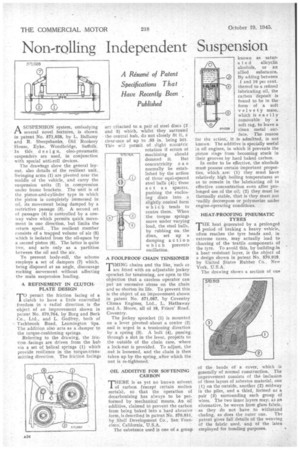Non-rolling Independent Suspension
Page 36

If you've noticed an error in this article please click here to report it so we can fix it.
A Resume of Patent Specifications That Have Recently Been Published
ASUSPENSION system, embodying several novel features, is shown M patent No. 571,028, by L. Ballainy and R. Sheepshanks, Old Rookery House, Eyke. Woodbridge, Suffolk. In this desig n, oleo-pneumatic suspenders are used, in conjunction with special anti-roll devices.
The drawings show the general layout, also details of the resilient Unit.. Swinging arms (1) are pivoted near the middle of the vehicle,. and carry the suspension units (2) in compression under frame brackets. The unit is of the piston-and-cylinder type in which The piston is completely immersed in oil, its movement being damped by a restrictive passage (3). Asecond set of passages (4) is controlled by a oneway valve which permits quick movement in one direction, but limits the return speed. , The resilient member consists of a trapped volume of air (5) which is isolated from the oil-space by a second piston (6). The latter is quite tree, and acts only as a partition between the oil and the air.
To prevent body-roll, the scheme employs a set of dampers (7) which, being disposed at an angle, discourage rocking movement without affecting the main suspension loading.
A REFINEMENT IN CLUTCHPLATE DESIGN TOpermit the friction facing of a clutch to have a little controlled freedom in a radial direction, is tihe object of an improvement shown in patent No. 570,764, by Borg and Beck Co„ •Ltd., and L. Godfrey, both of Tachbrook Road, Leamington Spa. The addition also acts as a damper to the torque-cushioning springs.
Referring to the drawing, the friction .facings are driven from the hub via a set of helical springs (1) which provide resilience in the torque-transmitting direction. The friction facings
are attached to a pair of steel discs (2 and 3) which, whilst they surround the•central hub, do not closely fit it, a clearmce of up to .05 in. being left. This wi;I permit of slight ezcentric rotation if errors of machining should demand it. But cencentricity c a n normally be established by the action Of three equi-spaced steel balls (9); these act as spacers, pushing the enclosing discs into a, slightly conical form which tends to centre them. When the torque springs move under varying load, the steel balls, by rubbing on, the discs, set up a damping action which prevents oscillation.
A FOOLPROOF CHAIN TENSIONER
TIMING chains and the like, such as
arc fitted with an adjustable jockey sprocket for tensioning, are open to the objection that a careless operator can put an excessive stress on the chain and so shorten its life. To prevent this is the object of an improvement shown in patent No. 571,087, by Coventry Climax Engines, Ltd., L. Hathaway and A. Moore, all of 16, Friars' Road, Coventry.
The jockey sprocket (1) is mounted on a lever pivoted, about a centre (2) and is urged in a tensioning direction by a spring (3). A bolt (4), passing_ through a slot in the lever, projects to the outside of the chain case, where a lock-nut is provided. To adjust, the nut is loosened, and the ,chain is then taken up by the spring, after which the nut is re-tightened:
OIL ADDITIVE FOR SOFTENING CARBON THERE is as yet no known solvent_ 1 of carbon (except certain molten metals), so that the operation of decarbonizing has always to be performed by mechanical means. An oil additive, claimed to prevent the carbon from being baked into a hard abrasive form, is described in patent No. 570,951, by Shell Development Co., San 'Francisco, California, U.S.A.
The substance used is one of a group known as satur ated alicyclic alcohols, or an allied substance. By adding between .1 and 10 per cent. thereof to a refined lubricating oil, the carbon deposit is found to be in the form of, a soft velvety mass, which is e a. sily removable by a soft rag, to leave a
571 028 clean metal sur face. The reason for the action., it is admitted, is not known. The additive is specially useful in oil engines, in which it prevents the piston rings from becoming stuck in their grooves by hard baked carbon.
In order to be effective, the alcohols must possess certain important properties, which ,are: (1) they must have relatively, high boiling temperatures so as to remain in the lubricating oil in effective concentration even after prolonged use of the oil; (2) they must be thermally stable, that is they must not -eadily decompose or polymerize under engine-operating conditions.
HEAT-PROOFING PNEUMATIC TYRES
THE heat kezierated by a prolonged period of braking a heavy vehicle. often reaches the tyre beads and, in extreme cases, may actually lead to charring of the textile components of the tyre. To avoid this, by building-in a heat resistant layer, is the object of a design shown in patent No. 570,919, by United States Rubber Co., New York, U.S.A.
The drawing shows a section of one of the beads of a cover, which is generally of normal construction. The improvement consists of the inclusion of three layers of asbestos material, one (I) on the outside, another (2) midway in the piles, and a third, formed as a pair (3) surrounding each group of wires. The two inner layers may, as an alternative, be woven from glass fabric, as they do not have to withstand chafing, as does the outer one. The patent gives full details of the weaving of the fabric used, and of the latex employed for bonding purposes.




















































